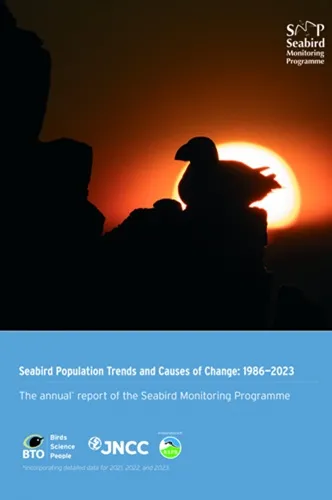BTO create and publish a variety of important articles, papers, journals and other publications, independently and with our partners, for organisations, government and the private sector. Some of our publications (books, guides and atlases) are also available to buy in our online shop.
Annual report of the Seabird Monitoring Programme
Seabird Population Trends and Causes of Change: 1986–2023
This report presents the latest seabird population trends in breeding abundance and productivity using data from the Seabird Monitoring Programme (SMP).
The report documents changes in the abundance and productivity of breeding seabird species in Britain and Ireland from 1986 to 2023, and provides a detailed account of the 2021, 2022 and 2023 breeding seasons.

Search settings
Hatching success in Lesser Black-backed Gulls Larus fuscus - an island case study of the effects of egg and nest site quality
Author: Ross-Smith, V.H., Johnston, A. & Ferns, P.N.
Published: 2015
Within an avian breeding population, there can be considerable variation in egg and nest site characteristics that have implications for individual reproductive success. Here we present a detailed case study of Lesser Black-backed Gulls Larus fuscus nesting on Flat Holm island, Wales, at a time when the colony was growing. This species is ground-nesting, with a modal clutch size of three. We surveyed 714 nests across the island during two consecutive years and recorded data on nest and egg characteristics, along with hatching success. We modelled how hatching success was associated with clutch size, egg volume, egg laying order and local habitat features, i.e. the amount of vegetation surrounding the nest and each nest's proximity to neighbouring nests. Eggs were most likely to hatch when they were laid in the middle of the season, were large in size, part of big clutches and in nests with a substantial amount of surrounding vegetation. Lesser Black-backed Gull productivity is currently low in many protected rural and coastal colonies throughout this species' range. Detailed information on factors influencing reproductive success could therefore indicate ways in which this species could be better managed to help maintain and conserve breeding populations.
01.01.15
Papers
Bird Trends 2015: trends in numbers, breeding success and survival for UK breeding birds
Author: Robinson, R.A., Marchant, J.H., Leech, D.I., Massimino, D., Sullivan, M.J.P., Eglington, S.M., Barimore, C., Dadam, D., Downie, I.S., Hammond, M.J., Harris, S.J., Noble, D.G., Walker, R.H. & Baillie, S.R.
Published: 2015
01.01.15
Reports
Comparison of trends in butterfly populations between monitoring schemes
Author: Roy, H.D.B., Ploquin, E.F., Randle, Z., Risely, K., Botham, M.S., Middlebrook, I., Noble, D., Cruickshanks, K. Freeman, S.N. & Brereton, T.M.
Published: 2014
10.12.14
Papers
The avoidance rates of collision between birds and offshore turbines
Author: Cook, A.S.C.P., Humphreys, E.M., Masden, E.A., Band, W. & Burton, N.H.K.
Published: 2014
Report of work carried out by the British Trust for Ornithology in collaboration with the Environmental Research Institute on behalf of the Marine Scotland Science.Accurately estimating birds’ risk of collision with offshore wind turbines is a key part of the decision-making process for proposed renewable developments. However, the evidence base for quantifying the number of birds likely to avoid colliding with turbines is limited. Recent BTO-led work helping to fill this gap, improving the understanding of the impacts of offshore renewables on marine wildlife.
03.12.14
Research reports Research reports
